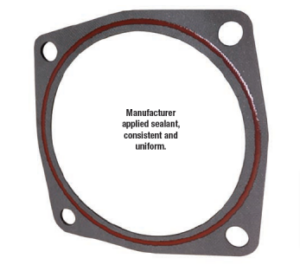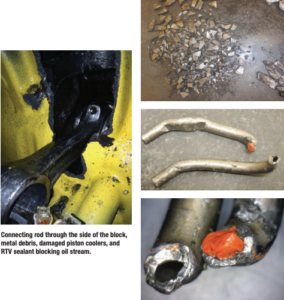




However, there are applications where the OE recommends adding various sealing compounds, and experienced technicians will know of applications and areas that benefit from adding them. That experience also tells them how much to use. The old saying that “more is better” can be far from the truth. It only stands to reason that if the liquid gasket maker or sealant is squeezing out … it’s also squeezing in!

Many of today’s industrial engines have piston cooling jets (tubes) that spray oil to the bottom of the piston to help cool them. Cooler jets (tubes) may be single or dual tube designs and are made from various metals or even plastics.

While investigating the cause of the failure, among all the broken pieces, a plugged cooler tube was found.
This small piece of loose sealant was enough to stop the oil flow and cause the piston to seize, and in this instance the operator was unable to get the engine shut down in time to salvage it.
The point of this article is not to say that gasket compounds are bad, but if the gasket is engineered correctly, and surface conditions are acceptable, a quality gasket should seal properly without adding them. There are times when you need to “MacGyver” a makeshift gasket with that odd roll of gasket material you have lying around the shop cabinet, a pair of scissors, and maybe a small ballpeen hammer. That might get you out of a pinch, and maybe that’s the appropriate time you want to add a little extra “something”. But serious engineering goes into developing a good quality gasket, and they rarely need to be altered.
Much like other internal engine parts, gasket materials have various ratings and specifications. The conditions that the gasket will be subjected to (temperature, oil, coolant, chemicals, etc.) must be considered during the development of the gasket:
Some materials are intended to swell once they are put into service. Adding sealing compounds may prevent the gasket from swelling properly. Surface finish is also a consideration and adding a compound can mask those surfaces and allow the gasket to slide.
This is not limited to just paper gaskets. Adding sealants can also affect molded gaskets, seals, and O-rings. If the compound being added is not compatible with the material the seal or O-ring is made of, over time, the seal will deteriorate and fail.
Like most other internal engine parts, gaskets and seals have had to evolve to withstand the demands and conditions of today’s industrial engines. Following the manufacturer’s installation instructions and the advice of an experienced technician is the best practice. If after reading this article you still feel the need to add sealing compounds on a quality conventional gasket or seal, you might want to consider the old Brylcreem jingle, “A Little Dab’ll Do Ya”.■
Steve Scott joined the service department at lPD in 1982, working with parts, service and sales for a variety of equipment, diesel, and natural gas engines. Since 2004, he has been the director of product development and technical support for lPD. For more information, email sscott@ipdparts.com.
If you’re an existing customer and already have a login, click here to find IPD quality parts.
If you would like to find an IPD distributor or become an IPD distributor, please fill out our form.